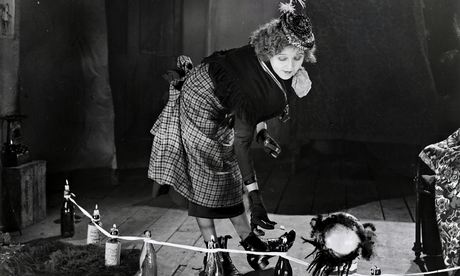
There are few who can claim to have seen the 1923 film Love, Life and Laughter, but the critic of the Manchester Guardian appears to have enjoyed it, acknowledging its masterpiece credentials and calling it "ambitious, spectacular" and "lit and photographed with a beauty to dream of".
Film-goers will now be able to decide for themselves. The BFI has announced, with some excitement, that the long lost film has been rediscovered in Amsterdam.
The rags to riches film starring Betty Balfour, the most successful female British actor of the 1920s, who was known as the Queen of Happiness, is one of the most sought after lost films, appearing on the BFI's most wanted list.
Bryony Dixon, curator of silent film at the BFI National Archive, called it "a major discovery". She received an email on Tuesday from her equivalent at the Dutch film institute, EYE. "I'm one of a handful of people for whom the title means anything at all and I had a sort of 'Oh my god' moment," she said. "It is very exciting for us, we've been looking for this one for a long time, so it's great news."
Audiences in 1923 considered Love, Life and Laughter, directed by George Pearson, to be one of the best British films.
Balfour, Britain's answer to Mary Pickford, stars as a chorus girl called Tip-toes who dreams of becoming a music hall star. She befriends a lonely boy who dreams of being a successful writer and they agree to meet back in their slum tenement in two years' time to see how their lives have turned out.
Pearson made many films with Balfour, in part because he was so infatuated with her – he was crushed she would not marry him.
Dixon said Pearson was one of Britain's most talented silent film directors."He launched Balfour's career and it is this film that really pushed her in to that stellar arena. She was our biggest star of the silent era. She was much loved and had that common touch, she was quite ordinary and she played on it."
The discovery is important also because only one other complete Pearson film – enititled Squibs Wins the Calcutta Sweep – exists, although the BFI has fragments of a detective thriller serial he made called Ultus, the Man from the Dead.
The rags to riches film was discovered last week in the EYE archives while researchers were going through a collection that arrived in November 2012. Film cans had been brought in from a building in the small Dutch town of Hattem, which, for three years after 1929, was used as a cinema. When the building was about to be redeveloped the man who discovered the cans brought them in to EYE hoping there might be second world war footage.
The film comes from a short golden age of British film-making when feature length silent films were being made for the British market. After 1924 most British studios went bust in the financial crisis, film reels being removed by bailiffs and burned or recycled. It is estimated that 80% of British silent films are lost.
But Dixon said the discovery of Love, Life and Laughter, which has been tinted and has Dutch intertitles, showed there was always room for hope.
The big one they are now looking for is Pearson's well received world war one film, Reveille, which, interestingly for a silent film, has a two-minute silence. "Wouldn't it just be the icing on the cake if it turned up in the centenary year?" said Dixon.
The hope is that the BFI will acquire a copy of Love, Life and Laughter, then screen it. Audiences can then see if the critics got it right; a Daily Telegraph writer said it was destined "to take its place among the screen classics".
The Manchester Guardian's critic Caroline Lejeune gave it a more nuanced review but praised Pearson as an artist, as well as the film.
Lejeune, who got her job on the Manchester Guardian because her mother was a friend of CP Scott, went on to become the Observer's film critic, writing for 32 generally honourable years until Hitchcock seems to have pushed her over the edge. She wrote of Psycho: "I couldn't give away the ending if I wanted to, for the simple reason that I grew so sick and tired of the whole beastly business that I didn't stop to see it." She then resigned from the paper.
A critic's take
Love, Life and Laughter is the latest Pearson film, and legend has it that the latest Pearson film is always the best. It is certainly the most ambitious, spectacular at times in the De Mille ballroom manner, lit and photographed with a beauty to dream of. Devotees have called it George Pearson's masterpiece, and so it is – of bluff. He lights common things uncommonly, and legend makes them symbolic; he catches a series of farcical situations, and legend makes them comic; legend turns sentimentality into sentiment, and confusion into mystery.
This fantasy of a chorus girl and a young poet is clever, but chiefly clever in simulating cleverness, in tickling the intellectual vanity of its audience with a goose feather, coloured peacock by imagination. It will succeed. And its success will be the result not of innate quality but of the great Welsh-Pearson legend – and, when all is said and done, nothing else matters.
CA Lejeune, for the Manchester Guardian, 2 June 1923

